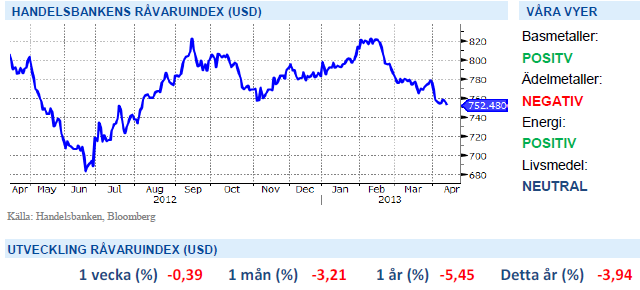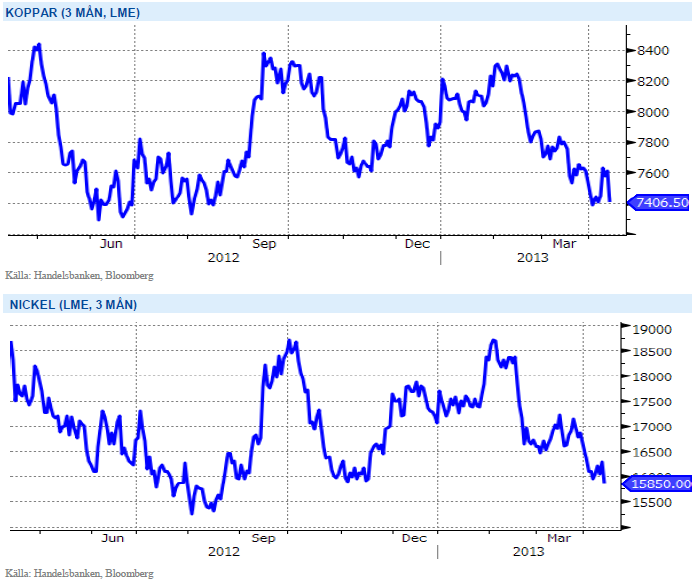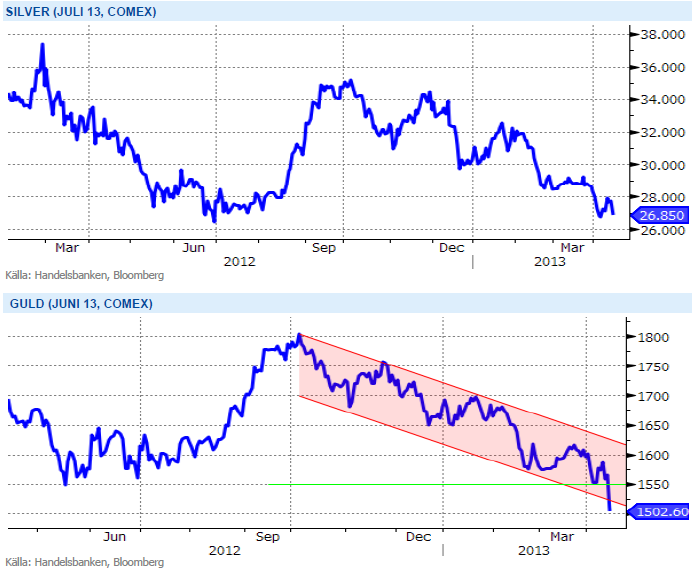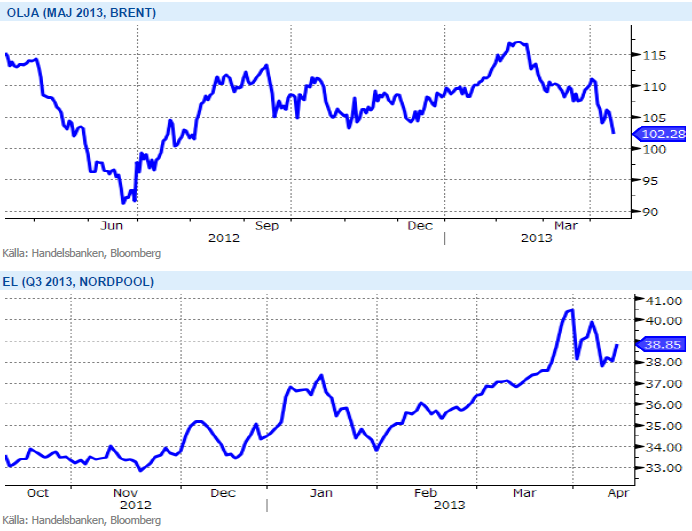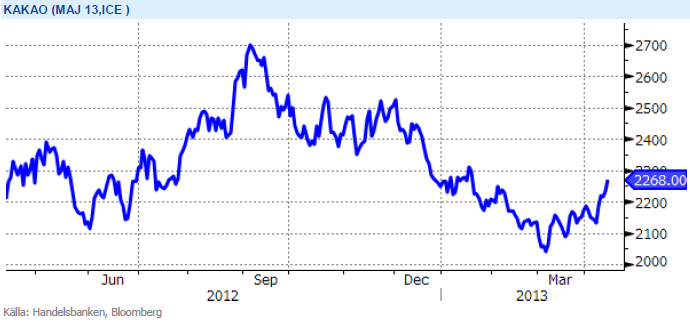Analys
SHB Råvarubrevet 12 april 2013

 Råvaror allmänt
Råvaror allmänt
Tilltagande makro-oro
Efter rädsla för den politiska processen kring Italien och Cypernröran i mars så har plötslig svaghet i både inköpschefsindex i EMU och USA gett motvind för sentimentet och de konjunkturhandlade råvarorna. Medan spridningseffekterna från Cypernstöket har blivit mycket modesta så oroar USA data oss. Amerikanska inköpschefsindex föll oväntat i mars, vilket lett till viss oro för att konjunkturdata kommer att upprepa resan vi sett under 2010-2012, då våren varit en tid med negativa överraskningar. Det oväntat låga sysselsättningsutfallet (payrolls) späder på denna oro. Även fredagens försäljningssiffror överraskade på nedsidan. Det intressanta är att den amerikanska börsen har skakat av sig denna plötsliga makrosvaghet helt och hållet medan räntemarknaden och råvaror har tagit den till sig med hull och hår.
Våra modeller antyder att USA inköpschefsindex bör stiga snarare än falla framöver. En stark börs brukar dessutom leda till förbättrad konsumtionstillväxt och högre investeringsefterfrågan. Finanspolitiken i USA har dock svängt om till åtstramning och kanske är detta vi nu ser i makro efter en oväntat stark inledning på året. Ännu vet vi inte vilken fot vi ska stå på men vi är klart försiktigare än tidigare under året. Kinadata har däremot varit bra under veckan med starkare import, lägre inflation och högre utlåning vilket fick de kinakänsliga basmetallerna att vända uppåt. Importen till Kina av de fyra viktigaste råvarorna, järnmalm, råolja, koppar och sojabönor var alla högre under mars än februari.
Basmetallerna
Kina stärker metallerna, USA tynger
Basmetaller har stigit under veckan och håller sina senaste stödnivåer efter att ökad optimism sprider sig kring utsikterna för ett starkare Q2 i Kina. Stark bankutlåning i mars och arbitragemöjligheter mellan kopparnoteringen på LME och Shanghai har ökat köpintresset hos kinesiska aktörer. Kopparpriset har följaktligen varit uppe och nosat på två veckors högsta under veckan, men föll tillbaka under fredagen och stänger veckan oförändrad.
Övriga metaller fick också se veckans tidigare uppgångar raderade efter sämre än väntade försäljningssiffror från USA. Störst nedgång noterades för tenn som under en timme föll med 3 %.
I tisdags gick 25 000 gruvarbetare i Chilenska koppargruvor ut i en 24 timmars strejk i ett försök att få bättre arbetsvillkor, säkerhetsregler och pensioner.
Trots nedgången senaste tiden tror vi på högre priser på basmetaller framöver och ser istället att dagens nivåer som köpvärda. Vi tror på: BASMET H
Ädelmetaller
Uppgång blev till nedgång
Efter att guldet har haft tillfälliga uppgångar drivit av Cypernoron och Japans QE aktion så tror vi åter att resan söderut fortsätter. Silver följer med som guldets spralliga lillebror medan vi behåller en långsiktig tro på högre pris på palladium och platina, givet deras betydelse som industrimetaller exponerade mot asiatisk fordonsindustri som går som tåget.
I förra veckan upprepade vi vår vy på fallande guld och bortsett ifrån en sväng uppe på nästan 1590, fick vi under veckan se resultatet av våra argument. Efter att ha brutit igenom stödnivån på 1550 föll guldet under fredag eftermiddag som lägst under 1500!
Starkare dollar och högre räntor blir utmanande för guldet samtidigt som inflationen väntas vara låg under året. Vi tror på: GULD S H
Energi
USA data fick oljan på fall
Oljan lyckades återhämta sig något under veckans första dagar för återigen försvagas på oro för Cypern och försäljningssiffror från USA inte motsvarade förväntningarna. Retail sales kom in på niomånaderslägsta vilket fick oljan ner till 101 USD/fat – på en nivå vi inte sett sedan juli 2012. Vi fortsätter tro att oljan har ett starkt stöd omkring 100 USD, såsom varit fallet i snart 2,5 år. Allt svagare makrodata har helt enkelt satt sina spår i makroråvaran nummer ett; oljan.
För elen har de senaste två veckornas rally drivits av den försenade våren och torrare väderlek ser ut att kunna fortsätta. Väderprognoserna som ligger inför nästa vecka visar på ett lågtryck som slår om mot högtryck med kallare och torrare väder. Energibalansen som försvagats ytterligare under veckan skulle därmed kunna försämras till hela -22 TWh vilket ger stöd för prisbilden. I övrigt förväntas nästa vecka handla mycket om EU Parlamentets omröstning nu på tisdag den 16/4 kring en eventuell backloadingplan.
Vi tror att både olja och el är fortsatt köpvärda. Vi tror på : ENERGI H
Livsmedel
Stigande konsumtion stödjer kakaopriset
Vårt starka case på fallande priser för soja, majs och vete efter den amerikanska torkan har spelat ut efter att priserna har fallit tillbaka till nivåerna före torkan. Om normalt väder infaller i år finns det dock fortfarande en riskpremie i soja majs och vete som kommer prisas ur när dagens låga lagernivåer börjar normaliseras. För europeiskt vete som våra certifikat är kopplade till finns en större nedsida än i det amerikanska vetet då Europa och Ryssland har ett senare odlingsår. Därmed vet vi idag mindre om statusen på årets skörd och en högre riskpremie är därför befogad.
Världsmarknadspriset på kakao nådde årshögsta (2744 dollar/ton) under september förra året. Detta som en följd av uteblivet regn och temperaturer över normalen under odlingssäsongen i regioner kring Elfenbenskusten, världens största kakaoexportör. Det råder därför osäkerhet kring storleken och kvalitén på årets skörd och priskurvan har varit uppåtgående sen i början av mars. Under de senaste två åren har priset fallit ca 20 procent som en följd av goda väderförhållanden och höga skördar som har varit huvudorsaken till överskott på kakao. Men de låga kakaopriserna har lett till att fler och fler kakaoodlare överväger att odla andra tropiska råvaror samtidigt som kakaokonsumtionen utanför Europa och Nordamerika ökar. Med risk för minskad produktion och i takt med stigande konsumtion i tillväxtländerna tror vi på fortsatt uppgång av priset.
Då priserna har på de stora jordbruksråvarorna soja, majs och vete har fallit tillbaka till nivåer före torkan i USA, tror vi att en nedsida är begränsad på kort sikt och därför är vi neutrala till utvecklingen för denna sektor.
Handelsbankens Råvaruindex
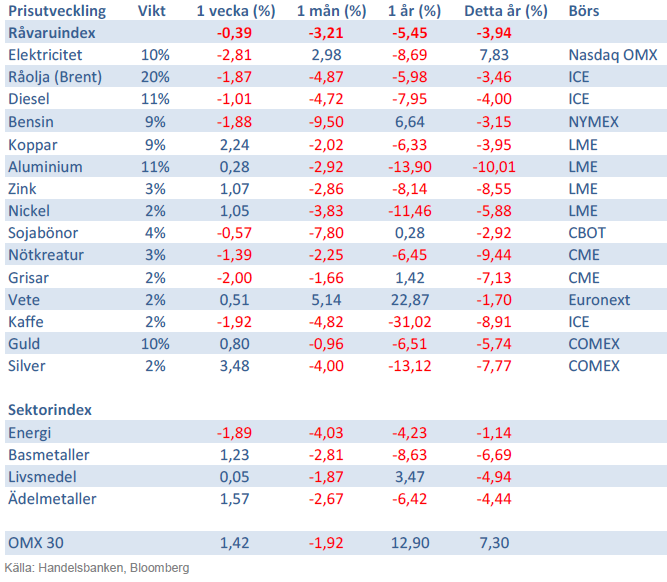
Handelsbankens råvaruindex består av de underliggande indexen för respektive råvara. Vikterna är bestämda till hälften från värdet av nordisk produktion (globala produktionen för sektorindex) och till hälften från likviditeten i terminskontrakten.
[box]SHB Råvarubrevet är producerat av Handelsbanken och publiceras i samarbete och med tillstånd på Råvarumarknaden.se[/box]
Ansvarsbegränsning
Detta material är producerat av Svenska Handelsbanken AB (publ) i fortsättningen kallad Handelsbanken. De som arbetar med innehållet är inte analytiker och materialet är inte oberoende investeringsanalys. Innehållet är uteslutande avsett för kunder i Sverige. Syftet är att ge en allmän information till Handelsbankens kunder och utgör inte ett personligt investeringsråd eller en personlig rekommendation. Informationen ska inte ensamt utgöra underlag för investeringsbeslut. Kunder bör inhämta råd från sina rådgivare och basera sina investeringsbeslut utifrån egen erfarenhet.
Informationen i materialet kan ändras och också avvika från de åsikter som uttrycks i oberoende investeringsanalyser från Handelsbanken. Informationen grundar sig på allmänt tillgänglig information och är hämtad från källor som bedöms som tillförlitliga, men riktigheten kan inte garanteras och informationen kan vara ofullständig eller nedkortad. Ingen del av förslaget får reproduceras eller distribueras till någon annan person utan att Handelsbanken dessförinnan lämnat sitt skriftliga medgivande. Handelsbanken ansvarar inte för att materialet används på ett sätt som strider mot förbudet mot vidarebefordran eller offentliggörs i strid med bankens regler.
Analys
More weakness and lower price levels ahead, but the world won’t drown in oil in 2026

Some rebound but not much. Brent crude rebounded 1.5% yesterday to $65.47/b. This morning it is inching 0.2% up to $65.6/b. The lowest close last week was on Thursday at $64.11/b.

The curve structure is almost as week as it was before the weekend. The rebound we now have gotten post the message from OPEC+ over the weekend is to a large degree a rebound along the curve rather than much strengthening at the front-end of the curve. That part of the curve structure is almost as weak as it was last Thursday.
We are still on a weakening path. The message from OPEC+ over the weekend was we are still on a weakening path with rising supply from the group. It is just not as rapidly weakening as was feared ahead of the weekend when a quota hike of 500 kb/d/mth for November was discussed.
The Brent curve is on its way to full contango with Brent dipping into the $50ies/b. Thus the ongoing weakening we have had in the crude curve since the start of the year, and especially since early June, will continue until the Brent crude oil forward curve is in full contango along with visibly rising US and OECD oil inventories. The front-month Brent contract will then flip down towards the $60/b-line and below into the $50ies/b.
At what point will OPEC+ turn to cuts? The big question then becomes: When will OPEC+ turn around to make some cuts? At what (price) point will they choose to stabilize the market? Because for sure they will. Higher oil inventories, some more shedding of drilling rigs in US shale and Brent into the 50ies somewhere is probably where the group will step in.
There is nothing we have seen from the group so far which indicates that they will close their eyes, let the world drown in oil and the oil price crash to $40/b or below.
The message from OPEC+ is also about balance and stability. The world won’t drown in oil in 2026. The message from the group as far as we manage to interpret it is twofold: 1) Taking back market share which requires a lower price for non-OPEC+ to back off a bit, and 2) Oil market stability and balance. It is not just about 1. Thus fretting about how we are all going to drown in oil in 2026 is totally off the mark by just focusing on point 1.
When to buy cal 2026? Before Christmas when Brent hits $55/b and before OPEC+ holds its last meeting of the year which is likely to be in early December.
Brent crude oil prices have rebounded a bit along the forward curve. Not much strengthening in the structure of the curve. The front-end backwardation is not much stronger today than on its weakest level so far this year which was on Thursday last week.

The front-end backwardation fell to its weakest level so far this year on Thursday last week. A slight pickup yesterday and today, but still very close to the weakest year to date. More oil from OPEC+ in the coming months and softer demand and rising inventories. We are heading for yet softer levels.

Analys
A sharp weakening at the core of the oil market: The Dubai curve

Down to the lowest since early May. Brent crude has fallen sharply the latest four days. It closed at USD 64.11/b yesterday which is the lowest since early May. It is staging a 1.3% rebound this morning along with gains in both equities and industrial metals with an added touch of support from a softer USD on top.

What stands out the most to us this week is the collapse in the Dubai one to three months time-spread.
Dubai is medium sour crude. OPEC+ is in general medium sour crude production. Asian refineries are predominantly designed to process medium sour crude. So Dubai is the real measure of the balance between OPEC+ holding back or not versus Asian oil demand for consumption and stock building.
A sharp weakening of the front-end of the Dubai curve. The front-end of the Dubai crude curve has been holding out very solidly throughout this summer while the front-end of the Brent and WTI curves have been steadily softening. But the strength in the Dubai curve in our view was carrying the crude oil market in general. A source of strength in the crude oil market. The core of the strength.
The now finally sharp decline of the front-end of the Dubai crude curve is thus a strong shift. Weakness in the Dubai crude marker is weakness in the core of the oil market. The core which has helped to hold the oil market elevated.
Facts supports the weakening. Add in facts of Iraq lifting production from Kurdistan through Turkey. Saudi Arabia lifting production to 10 mb/d in September (normal production level) and lifting exports as well as domestic demand for oil for power for air con is fading along with summer heat. Add also in counter seasonal rise in US crude and product stocks last week. US oil stocks usually decline by 1.3 mb/week this time of year. Last week they instead rose 6.4 mb/week (+7.2 mb if including SPR). Total US commercial oil stocks are now only 2.1 mb below the 2015-19 seasonal average. US oil stocks normally decline from now to Christmas. If they instead continue to rise, then it will be strongly counter seasonal rise and will create a very strong bearish pressure on oil prices.
Will OPEC+ lift its voluntary quotas by zero, 137 kb/d, 500 kb/d or 1.5 mb/d? On Sunday of course OPEC+ will decide on how much to unwind of the remaining 1.5 mb/d of voluntary quotas for November. Will it be 137 kb/d yet again as for October? Will it be 500 kb/d as was talked about earlier this week? Or will it be a full unwind in one go of 1.5 mb/d? We think most likely now it will be at least 500 kb/d and possibly a full unwind. We discussed this in a not earlier this week: ”500 kb/d of voluntary quotas in October. But a full unwind of 1.5 mb/d”
The strength in the front-end of the Dubai curve held out through summer while Brent and WTI curve structures weakened steadily. That core strength helped to keep flat crude oil prices elevated close to the 70-line. Now also the Dubai curve has given in.

Brent crude oil forward curves

Total US commercial stocks now close to normal. Counter seasonal rise last week. Rest of year?

Total US crude and product stocks on a steady trend higher.

Analys
OPEC+ will likely unwind 500 kb/d of voluntary quotas in October. But a full unwind of 1.5 mb/d in one go could be in the cards

Down to mid-60ies as Iraq lifts production while Saudi may be tired of voluntary cut frugality. The Brent December contract dropped 1.6% yesterday to USD 66.03/b. This morning it is down another 0.3% to USD 65.8/b. The drop in the price came on the back of the combined news that Iraq has resumed 190 kb/d of production in Kurdistan with exports through Turkey while OPEC+ delegates send signals that the group will unwind the remaining 1.65 mb/d (less the 137 kb/d in October) of voluntary cuts at a pace of 500 kb/d per month pace.

Signals of accelerated unwind and Iraqi increase may be connected. Russia, Kazakhstan and Iraq were main offenders versus the voluntary quotas they had agreed to follow. Russia had a production ’debt’ (cumulative overproduction versus quota) of close to 90 mb in March this year while Kazakhstan had a ’debt’ of about 60 mb and the same for Iraq. This apparently made Saudi Arabia angry this spring. Why should Saudi Arabia hold back if the other voluntary cutters were just freeriding? Thus the sudden rapid unwinding of voluntary cuts. That is at least one angle of explanations for the accelerated unwinding.
If the offenders with production debts then refrained from lifting production as the voluntary cuts were rapidly unwinded, then they could ’pay back’ their ’debts’ as they would under-produce versus the new and steadily higher quotas.
Forget about Kazakhstan. Its production was just too far above the quotas with no hope that the country would hold back production due to cross-ownership of oil assets by international oil companies. But Russia and Iraq should be able to do it.
Iraqi cumulative overproduction versus quotas could reach 85-90 mb in October. Iraq has however steadily continued to overproduce by 3-5 mb per month. In July its new and gradually higher quota came close to equal with a cumulative overproduction of only 0.6 mb that month. In August again however its production had an overshoot of 100 kb/d or 3.1 mb for the month. Its cumulative production debt had then risen to close to 80 mb. We don’t know for September yet. But looking at October we now know that its production will likely average close to 4.5 mb/d due to the revival of 190 kb/d of production in Kurdistan. Its quota however will only be 4.24 mb/d. Its overproduction in October will thus likely be around 250 kb/d above its quota with its production debt rising another 7-8 mb to a total of close to 90 mb.
Again, why should Saudi Arabia be frugal while Iraq is freeriding. Better to get rid of the voluntary quotas as quickly as possible and then start all over with clean sheets.
Unwinding the remaining 1.513 mb/d in one go in October? If OPEC+ unwinds the remaining 1.513 mb/d of voluntary cuts in one big go in October, then Iraq’s quota will be around 4.4 mb/d for October versus its likely production of close to 4.5 mb/d for the coming month..
OPEC+ should thus unwind the remaining 1.513 mb/d (1.65 – 0.137 mb/d) in one go for October in order for the quota of Iraq to be able to keep track with Iraq’s actual production increase.
October 5 will show how it plays out. But a quota unwind of at least 500 kb/d for Oct seems likely. An overall increase of at least 500 kb/d in the voluntary quota for October looks likely. But it could be the whole 1.513 mb/d in one go. If the increase in the quota is ’only’ 500 kb/d then Iraqi cumulative production will still rise by 5.7 mb to a total of 85 mb in October.
Iraqi production debt versus quotas will likely rise by 5.7 mb in October if OPEC+ only lifts the overall quota by 500 kb/d in October. Here assuming historical production debt did not rise in September. That Iraq lifts its production by 190 kb/d in October to 4.47 mb/d (August level + 190 kb/d) and that OPEC+ unwinds 500 kb/d of the remining quotas in October when they decide on this on 5 October.

-

 Analys4 veckor sedan
Analys4 veckor sedanVolatile but going nowhere. Brent crude circles USD 66 as market weighs surplus vs risk
-

 Nyheter4 veckor sedan
Nyheter4 veckor sedanAktier i guldbolag laggar priset på guld
-

 Nyheter4 veckor sedan
Nyheter4 veckor sedanKinas elproduktion slog nytt rekord i augusti, vilket även kolkraft gjorde
-

 Nyheter4 veckor sedan
Nyheter4 veckor sedanTyskland har så höga elpriser att företag inte har råd att använda elektricitet
-

 Nyheter4 veckor sedan
Nyheter4 veckor sedanDet stigande guldpriset en utmaning för smyckesköpare
-

 Nyheter3 veckor sedan
Nyheter3 veckor sedanEtt samtal om guld, olja, fjärrvärme och förnybar energi
-

 Analys4 veckor sedan
Analys4 veckor sedanBrent crude ticks higher on tension, but market structure stays soft
-

 Nyheter2 veckor sedan
Nyheter2 veckor sedanOPEC+ missar produktionsmål, stöder oljepriserna


